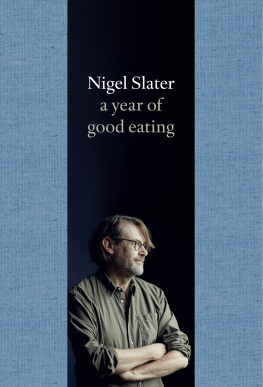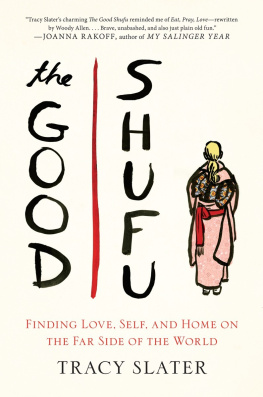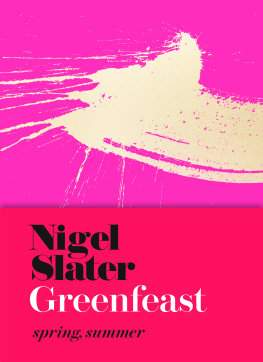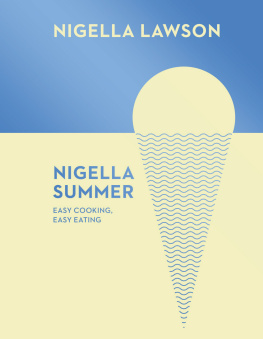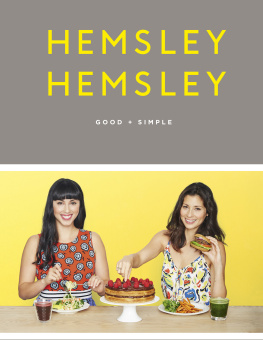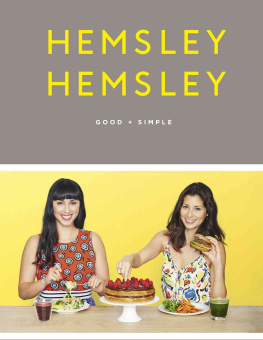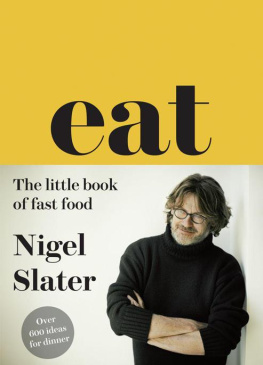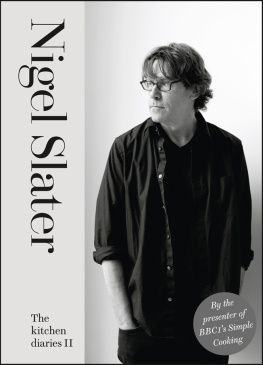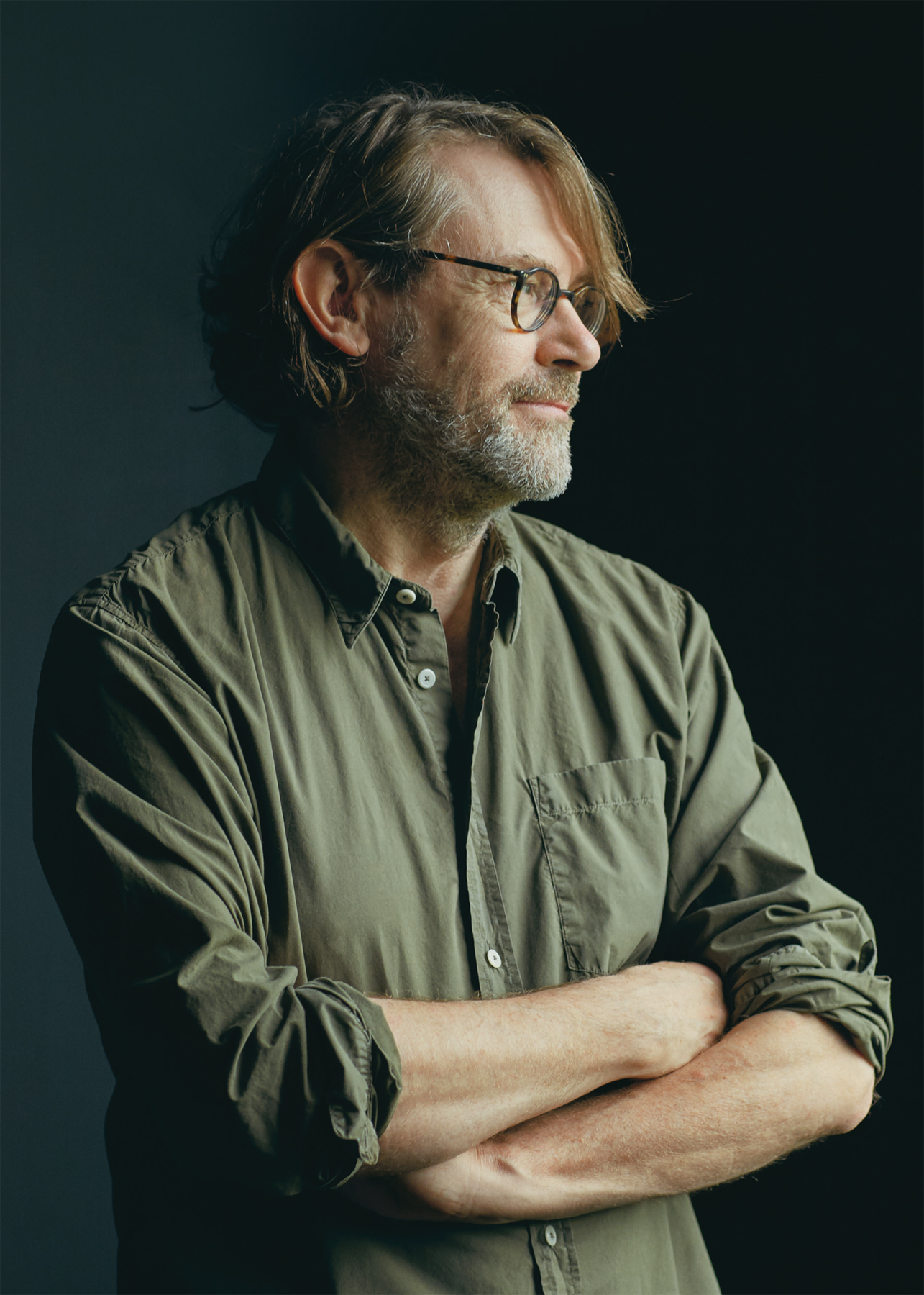Fourth Estate
The News Building
1 London Bridge Street
London SE1 9GF
An imprint of HarperCollinsPublishers
www.4thestate.co.uk
First published in Great Britain by Fourth Estate in 2015
Text copyright Nigel Slater 2015
Photographs Jonathan Lovekin 2015
except Nigel Slater portrait on Jenny Zarins
Instagram pictures Nigel Slater
James Thompson picture Christina Solomons
Nigel Slater asserts the moral right to be identified as the author of this work
A catalogue record for this book is available from the British Library
Source ISBN: 978-0-00-753680-1
Ebook Edition July 2015 ISBN: 978-0-00-815370-0
Version 2015-09-18
All rights reserved under International and Pan-American Copyright Conventions. By payment of the required fees, you have been granted the non-exclusive, non-transferable right to access and read the text of this e-book on-screen. No part of this text may be reproduced, transmitted, down-loaded, decompiled, reverse engineered, or stored in or introduced into any information storage and retrieval system, in any form or by any means, whether electronic or mechanical, now known or hereinafter invented, without the express written permission of HarperCollins e-books.
For James
A note on the type
Monotype Haarlemmer was originally designed by Jan van Krimpen (18921958), but never finished. Working from van Krimpens original drawings, Frank E. Blokland completed the family for the Dutch Type Library in 2002.
ITC Johnston was designed by Richard Dawson and Dave Farey in 1999 and is based on Edward Johnstons lettering for The Underground Group, London (introduced in 1916 and still in use today).
Contents
We are not here for long.
So lets at least make ourselves something good to eat.
A lovingly kneaded loaf; a casserole of beef, garlic, thyme, stock and onions you have left to its own devices in a slow oven; a salad that crunches and crackles with young, spring leaves and sprouted seeds. A sandwich maybe, its hot filling of roast pork and crackling peeking tantalisingly from between two pieces of bread. A fool. A tart. A sticky rib. The possibilities are infinite.
I have been cooking, on an almost daily basis, for five decades. I have eaten the great, the good and things I rather wish I hadnt. As a cook, and indeed as a cookery writer, I have got things right, wrong and somewhere in between. But what never changes is my curiosity and my appetite. That, and the endless delight I get from giving people, loved ones, friends, complete strangers, something good to eat.
Just as with music or literature, there are the classics of which I never tire, yet the excitement of finding new works never dims. For me, it is the same with food. You know how it is. There are old favourites you make over and over, recipes that become part of the rhythm of your life, and then there is the stuff of fresh thinking, cooking that is spontaneous and spirited.
What has always mattered to me is that we enjoy not just the end result, but the hands-on craft along the way, the act of making ourselves and others a meal. Cooking has, for this cook at least, never been purely about the end result. It is the small, joyous details of cooking that have made it a lifelong pleasure.
The recipes
I enjoy my work more with each passing year. And never more so than when I hear or say the words What shall we have to eat? The point in my working day when food is no longer something on the page or the screen, but becomes something on a plate.
Between the pages of this, the third volume of my kitchen diaries, is a collection of good things I have eaten over the last few years. Recipes, moments and ideas I would like to share with you.
Does the world need more recipes? I like to think so. Cooking doesnt stand still, at least not for anyone with spirit, an appetite and a continuing sense of wonder. No one is exactly re-inventing the wheel in cookery nowadays, no matter what they might think, but there is still much fun to be had.
A cookery book can open a door to a world of delicious possibilities. As I hope this one will. Discovering a new way with a familiar ingredient; a reworking of an old friend; a twist, a turn, a whim or even just a simple reminder. The recipes are here to follow word for word or simply to spark your imagination, as you wish.
There are new things here: sausage fried with sauerkraut and mushrooms; the cheese, gherkins and ham of an alpine raclette turned into a tart; steak braised with sake; chicken cooked with haricot beans and lemon; friands of candied orange and bitter chocolate. There is a curry with a pungent coriander herb paste for the adventurous, and a bergamot water ice whose citrus notes will make anyones eyes sparkle.
There are chapters you may simply want to read before you go to sleep at night the pork bone soup simmered for three hours, for instance; and others you may want to make immediately the grilled chicken with miso and yuzu, or perhaps the ice cream with burnt butter and toasted almonds.
There are recipes to pounce upon gleefully: tender maple biscuits that are the very essence of autumn; a salad of warm roast chicken and ripe melon for a summer lunch; grilled asparagus with an almost soupy lemon mash; gnocchi cooked with cream and dolcelatte for a winters night and langoustines in butter with Parmesan-flecked juices to lick, hot and salty, from your fingers.
I have included recipes for those who love to cook and feel the ingredients in their hands (tartlets of figs and red onions poised somewhere between sweet and savoury, or a blackberry shortbread almost too crumbly to lift). But at least half of them are written for those who need simple, useful recipes for the end of a working day.
The grace of understatement
But there is something else. With this book comes something of a plea for both good food and a love of cooking to be just part and parcel of our everyday lives. Thoughtful, considered, always delicious, but something to be quietly enjoyed rather than put on a pedestal. (The very notion of someone being a foodie makes me shudder.)
I worry that the competitive element currently prevalent in food and cooking is scaring people, particularly new cooks, away from getting stuck in. There is, I believe, too much pressure on us to perform, to reach for perfection, instead of simply treating the art of making something to eat as the lifelong joy it should be.
I like to think I have an attitude to cooking and eating built on foundations of good taste and pleasure rather than of veneration and worship. Yes, I like eating the good stuff and I cook from scratch pretty much every day of my life, but I cant help thinking good food should be something we take in our stride, a life-enriching punctuation to our day, rather than something to be fetishised. And if I read once more that someone is a passionate cook I think Ill eat my oven gloves.
A healthy attitude to eating
I am concerned about the current victimisation of food. The apparent need to divide the contents of our plates into heroes and villains. The current villains are sugar and gluten, though it used to be fat, and before that it was salt (and before that it was carbs and... oh, Ive lost track). It is worth remembering that todays devil will probably be tomorrows angel and vice versa.
We risk having the life sucked out of our eating by allowing ourselves to be shamed over our food choices. If this escalates, historians may look back on this generation as one in which societys decision about what to eat was driven by guilt and shame rather than by good taste or pleasure. Well, not on my watch.

